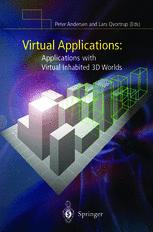

Most ebook files are in PDF format, so you can easily read them using various software such as Foxit Reader or directly on the Google Chrome browser.
Some ebook files are released by publishers in other formats such as .awz, .mobi, .epub, .fb2, etc. You may need to install specific software to read these formats on mobile/PC, such as Calibre.
Please read the tutorial at this link: https://ebookbell.com/faq
We offer FREE conversion to the popular formats you request; however, this may take some time. Therefore, right after payment, please email us, and we will try to provide the service as quickly as possible.
For some exceptional file formats or broken links (if any), please refrain from opening any disputes. Instead, email us first, and we will try to assist within a maximum of 6 hours.
EbookBell Team

5.0
88 reviews3D Virtual Applications: Applications with Virtual Inhabited 3D Worlds deals with the use of virtual inhabited 3D spaces in different domains of society. (Other volumes deal with interaction, production methodology and space.) From focusing on virtual reality (a reality into which users and objects from the real world should be moved) we are increasingly focusing on augmented reality (i.e. on moving computers out into the reality of real users, objects and activities). This book deals with the use of virtual inhabited 3D spaces in both contexts. Based on the structuring of the application domains, this book looks at the use of VR and augmented reality in the following major application domains:
- Production oriented applications - use of VR and augmented reality for control of complex production plants, for navigation support (ships, cars, aeroplanes) and for support of collaborative work processes
- Communication support applications - virtual spaces are used for supporting communication in learning environments and for support of organisational communication. Also virtual spaces are used for supporting the navigation of people in public spaces, i.e. as maps, planning tools
- Scientific applications - use of 3D models for medical research; use of dynamic models for representation of abstract concepts and ideas (data-mining applications); use of dynamic 3D models for simulating biological or social processes
- Artistic and cultural applications - the construction of stages representing concepts and/or emotions